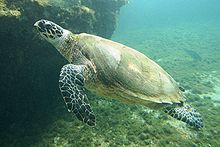- Marine reptile
-
Marine reptiles are reptiles which have become secondarily adapted for an aquatic or semi-aquatic life in a marine environment.
The earliest marine reptiles arose in the Permian period during the Paleozoic era. During the Mesozoic era, many groups of reptiles became adapted to life in the seas, including such familiar clades as the ichthyosaurs, plesiosaurs (these two orders were once thought united in the group "Enaliosauria,"[1] a classification now cladistically obsolete), mosasaurs, nothosaurs, placodonts, thalattosaurs and thalattosuchians.
After the mass extinction at the end of the Cretaceous period, marine reptiles were less numerous. Extant marine reptiles include marine iguanas, sea snakes, sea turtles and saltwater crocodiles.
Some marine reptiles, such as ichthyosaurs and mosasaurs, rarely ventured onto land and gave birth in the water. Others, such as sea turtles and saltwater crocodiles, return to shore to lay their eggs. Some marine reptiles also occasionally rest and bask on land.
References
- ^ Williston SW (1914) Water Reptiles of the Past and Present University of Chicago Press (reprint 2002). ISBN 1-4021-4677-9
See also
Categories:- Marine reptiles
- Reptile stubs
Wikimedia Foundation. 2010.



